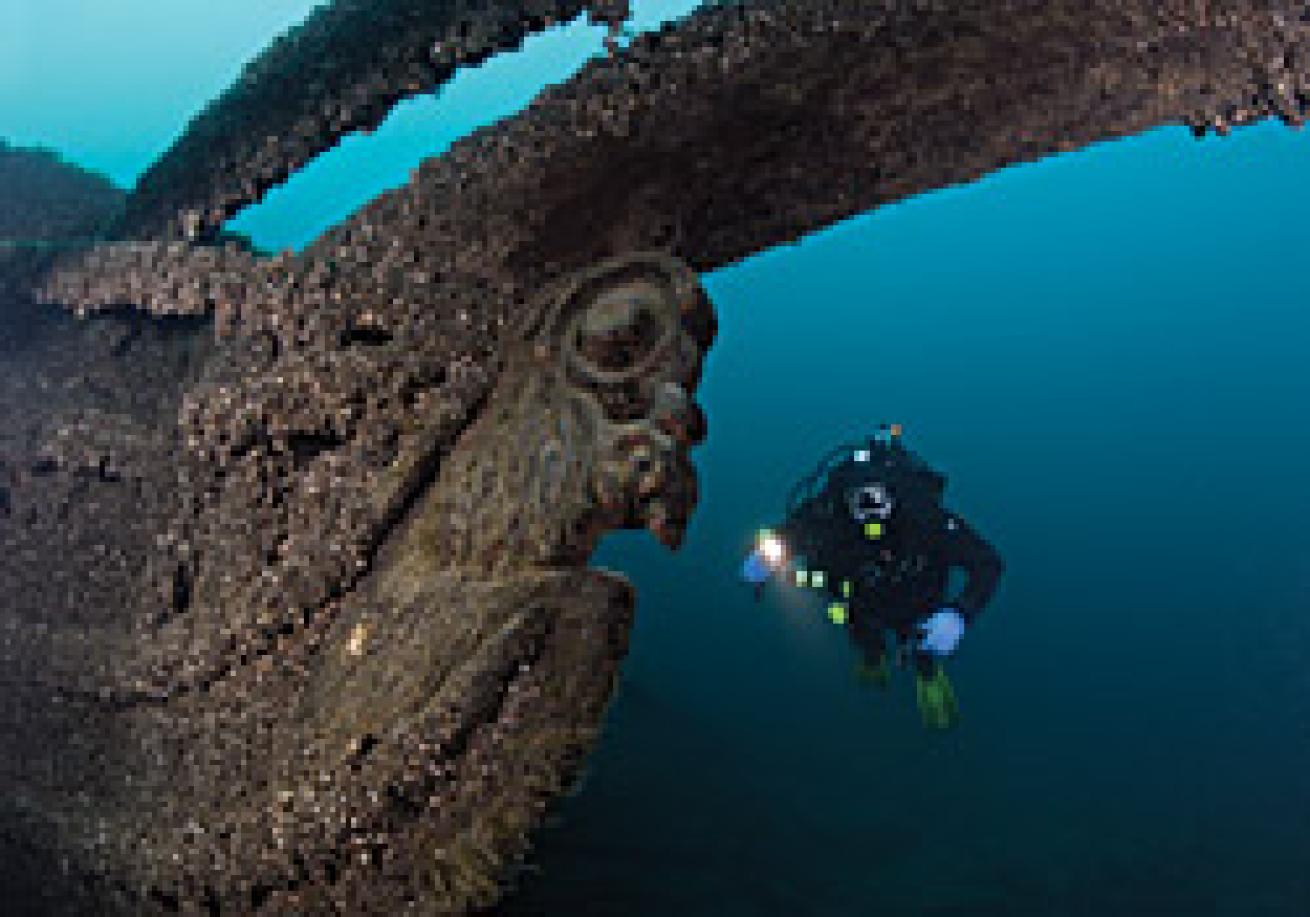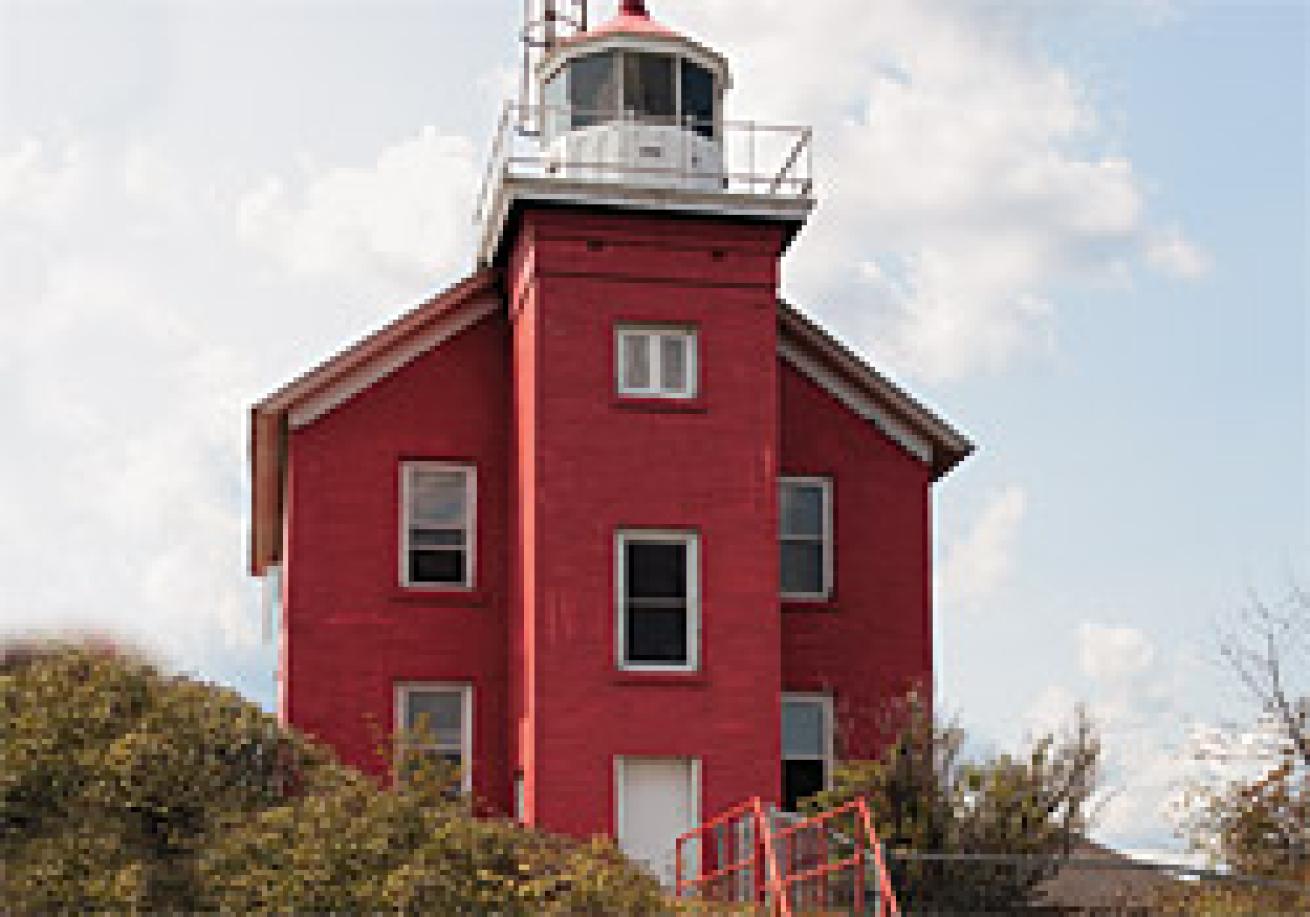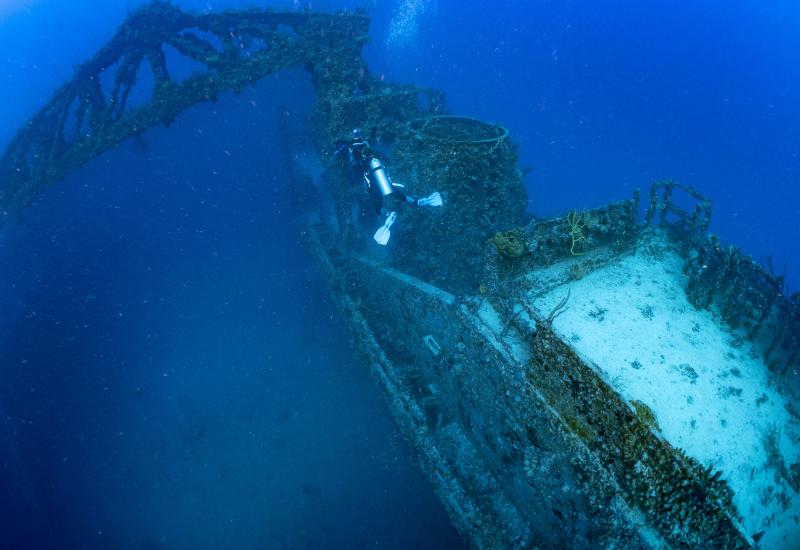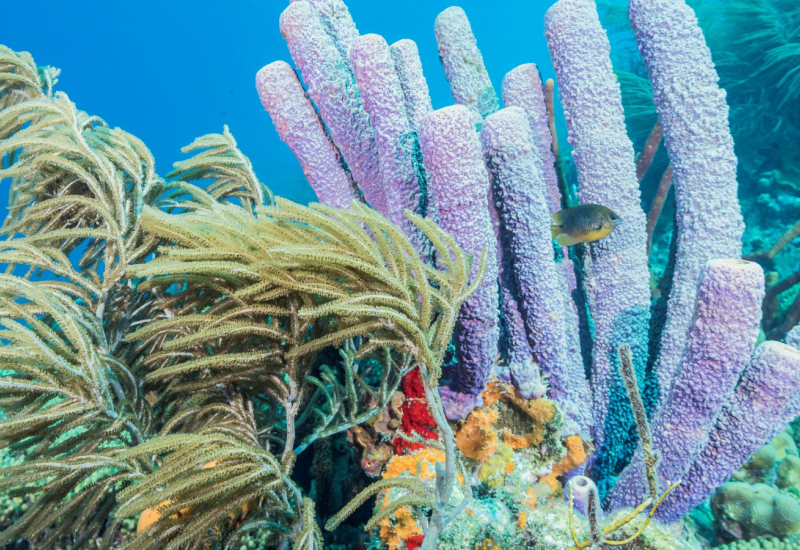Shipwrecks of Northern Michigan

February 2007
By Jim Lima
Photography by Brandon Cole
As I descend the line from the surface buoy, the dark shape below morphs into the unmistakable form of a sailing ship. At 60 feet, I hover above the 130-foot-long Maitland, orienting myself for a stem-to-stern survey. The Maitland is one of the many exceptional shipwrecks that draw divers to Michigan's Upper Peninsula, or the "U.P."
In its decade sailing the Great Lakes, the Maitland survived many mishaps before an accident sent it to the bottom of the Straits of Mackinac, the passage at the northern tip of two Great Lakes, Lake Michigan and Lake Huron. Capt. Larry MacElroy, of the dive boat Rec Diver, calls the Maitland the "good luck/bad luck wreck." On a clear night in June 1871, "the lookout spotted an oncoming vessel," he says. "The Maitland turned hard to avoid a collision. Its bowsprit tangled and broke away with the rigging and a mast from the other boat, but both ships stayed afloat. But the Maitland's good luck had been used. Moments later, an unseen second vessel hit it square, slicing through the hull. The Maitland went down in five minutes."
We find evidence of the first collision: the bowsprit's stub pokes from the front of the wreck. On the foredeck, we inspect the massive sampson post, the windlass and other fixtures. We drop to the main deck, where a hatch opening reveals a cavernous hold, but entering the wreck is not part of our dive plan. A gap in the starboard gunwale catches my attention. The point of second impact! Kicking over, I discover staved-in timbers that breach the hull from top to bottom. I experience an unexpected twinge of sadness while probing the fatal rupture, evidence of the ship's tragic ending.
Wrecks of the Straits of Mackinac
The Straits funneled ships into a confined area, which, in conspiracy with the weather, created a wreck-rich environment. The Maitland is among 13 of the main historic wrecks in or adjacent to the Straits of Mackinac Underwater Preserve. Most of these sites are advanced dives because of depth (many are deeper than 75 feet) and variable current.
We motor east to dive the Sandusky, the preserve's oldest wreck. It foundered in a September 1856 gale with the loss of all hands. Well-preserved in Lake Michigan's cold waters, it sits upright in about 85 feet of water, with the deck at 70 feet. The photogenic bow features a prominent jib boom and bowsprit, and the site's most unique feature, a ram-shaped figurehead. We make our way around collapsed masts, anchors, the windlass and other remains strewn about the bow and bottom.
The Sandusky and the Maitland appear swathed with an uneven, rough-textured coat that turns out to be countless thumbnail-sized zebra mussels. This non-native species, most likely introduced in ballast water discharged from a transoceanic vessel in the late 1980s, has spread quickly across much of the Great Lakes.
Alger Underwater Preserve
A two-hour drive through a landscape of farmland and forests takes us from St. Ignace to Munising, on the U.P.'s north shore. We dive a cluster of wrecks, many of which are well suited for novice divers, in Lake Superior's Alger Underwater Preserve.
From our boat's deck, we can easily make out the submerged outline of the Bermuda. The Bermuda sank twice, foundering in 1870 while carrying a cargo of iron ore and again 13 years later after being raised during salvage. The top of the stern sits in about 12 feet of water with the bottom of the bow around 30 feet. "If you have any problem on the wreck," quips our captain, Peter Linquist, during the briefing, "stand on the deck, wave your hand, and you'll be OK."
Descending to the Bermuda's bow, we find its largely intact hull devoid of encrusting zebra mussels. The caulking between the planks still looks tight; the hull appears as if it could be refloated and repaired and then resume duty. We find remnants of the iron ore cargo in the hold and scattered on deck.
In contrast, our dive in 20 to 40 feet of water on the nearby Manhattan reveals a confusing pile of broken timbers inhabited by scores of crayfish. This site invites us to solve the jigsaw puzzle of how these pieces relate to one another. The wreck sits adjacent to the boulder reef that stranded the ship and broke open its hull. Charred timbers mark the fire that finished it off. We can make out depth markings, indicated by the Roman numerals XIV and XV, on the detached rudder.
The Smith Moore, a wood-hulled steamer lost in an 1889 collision, is deeper, colder and more exposed to the elements than the two nearby sites, making it an advanced dive. As suggested in our predive briefing, we descend on the buoy line and limit our exploration to the wreck's stern. Circling the deck, we come across portions of the steam engine, piping and plumbing. Pulleys and other implements hang from the railing, and a fine sand coating covers much of the deck. We descend to a maximum of 80 feet during the dive; published dive guides indicate a greater depth, but the bottom's shifting sands constantly change the conditions at this site.
Keweenaw Underwater Preserve
We load the van for the four-hour trip to Copper Harbor, our final destination. The journey takes us through the Huron Mountains before we head up the Keweenaw Peninsula, which juts into Lake Superior. We emerge at the town of Copper Harbor, which literally sits at the end of a beautiful, tree-shaded road.
Aboard the charter boat Equinox, we cruise toward the former Coast Guard buoy tender Mesquite, one of several wrecks in the Keweenaw Underwater Preserve. After running aground in 1988 and being damaged beyond repair, the Mesquite was intentionally scuttled in about 110 feet of water to create a dive site. Rounding Keweenaw Point, we feel the bump of three-foot seas driven by easterly winds. Lake diving may conjure visions of idyllically calm water, but these inland seas exhibit the same unpredictable temperament as their saltwater cousins.
We giant-stride into the water and descend to the vessel 80 feet below. The Mesquite turns out to be in excellent condition, offering a variety of deck machinery and other fittings and diver-accessible compartments.
We run back to Copper Harbor to dive the Wasaga, marked by a buoy fashioned from an aluminum beer barrel. The ship burned and sank in the harbor in 1910. Today, the site consists of a jumble of timbers, some of which still show marks of the vessel's fiery demise. Like the Manhattan, this dive is fairly easy, with widely scattered wreckage in 20 to 40 feet of water. Closer inspection reveals bricks, coal, spools of rusting barbed wire and other remnants of its cargo of farm machinery.
Freshwater diving eliminates the need for a lengthy gear rinse at the end of the dive, so we quickly pile into the van and backtrack to Marquette. While flying prevents us from diving in the Marquette Underwater Preserve, the city's maritime museum, lighthouse and ore-loading docks provide a larger context for the wrecks we did explore.
The 11 underwater preserves that ring Michigan do more than protect historically significant wrecks in historically significant areas. They allow divers of all skill levels to experience the thrill of discovery that comes with exploring a shipwreck.
InDepth
Getting Around: The Upper Peninsula has an excellent road system with access to St. Ignace via Interstate 75 and the Mackinac Bridge, from Canada through Sault Ste. Marie, and from several points in Wisconsin.
Dive Conditions: The best diving conditions in the preserves occur in July and August, but can remain good until after Labor Day. Depending on location and conditions, diving generally opens in late April or early May when the preserve associations place buoys on the wrecks and usually ends sometime between mid-September and early October when the buoys are removed. Visibility varies, but commonly exceeds 20 to 40 feet during the peak season. Water temperatures at the surface during the peak season can be in the upper 50s or warmer. Weather conditions can make the lakes "turn over," bringing colder water to the surface. Temperatures on the deeper wrecks generally hover in the upper 40s or colder. In any case, a dry suit is recommended, but some divers opt for thick wetsuits.
Dive Outfitters and Charters: For most trips, two-tank dives are the norm, with scheduled trips in the morning and afternoon. Most dive outfitters and charters operate seasonally and part-time. Dive charters accommodate three to 24 divers. Rental gear is available but limited. While same-day, walk-on diving is possible on some boats, reservations are highly recommended.
Straits of Mackinac Underwater Preserve: In St. Ignace, Straits Scuba Center, www.straitsscuba.com, and Abyss Dive Charters, www.abyssdivecharters.com.
In Mackinac City, Great Lakes Dive Charters, www.greatlakesdivecharters.com.
In Traverse City, Scuba North, www.scubanorth.com.
Alger Underwater Preserve: In Musining, Shipwreck Tours, www.shipwrecktours.com, and Northstar Charters, www.lakesuperiordiving.com.
Keweenaw Underwater Preserve: In Copper Harbor, A Superior Divers Center, www.asuperiordive.com, and Fred's Charters, www.copperharbor.org/site_files/freds.html.
Topside Activities: The Upper Peninsula is renowned for its maritime sites, including shipwrecks, underwater preserves, lighthouses and maritime museums.
Information on the UP is available from these web sites: Upper Peninsula Travel, www.uptravel.com • Marquette Convention and Visitors Bureau, www.marquettecountry.org • Straits of Mackinac Underwater Preserve, St. Ignace Visitors Bureau, www.stignace.com • Alger Underwater Preserve, Alger County Chamber of Commerce, www.algercounty.org • Keweenaw Underwater Preserve, Copper Harbor, www.copperharbor.org.
Note: While Michigan's Underwater Preserve system protects wrecks in designated areas, removing any artifact from any wreck anywhere on the state's bottom lands is illegal. Information on diving the various preserves and wrecks can be found at www.michiganpreserves.org.
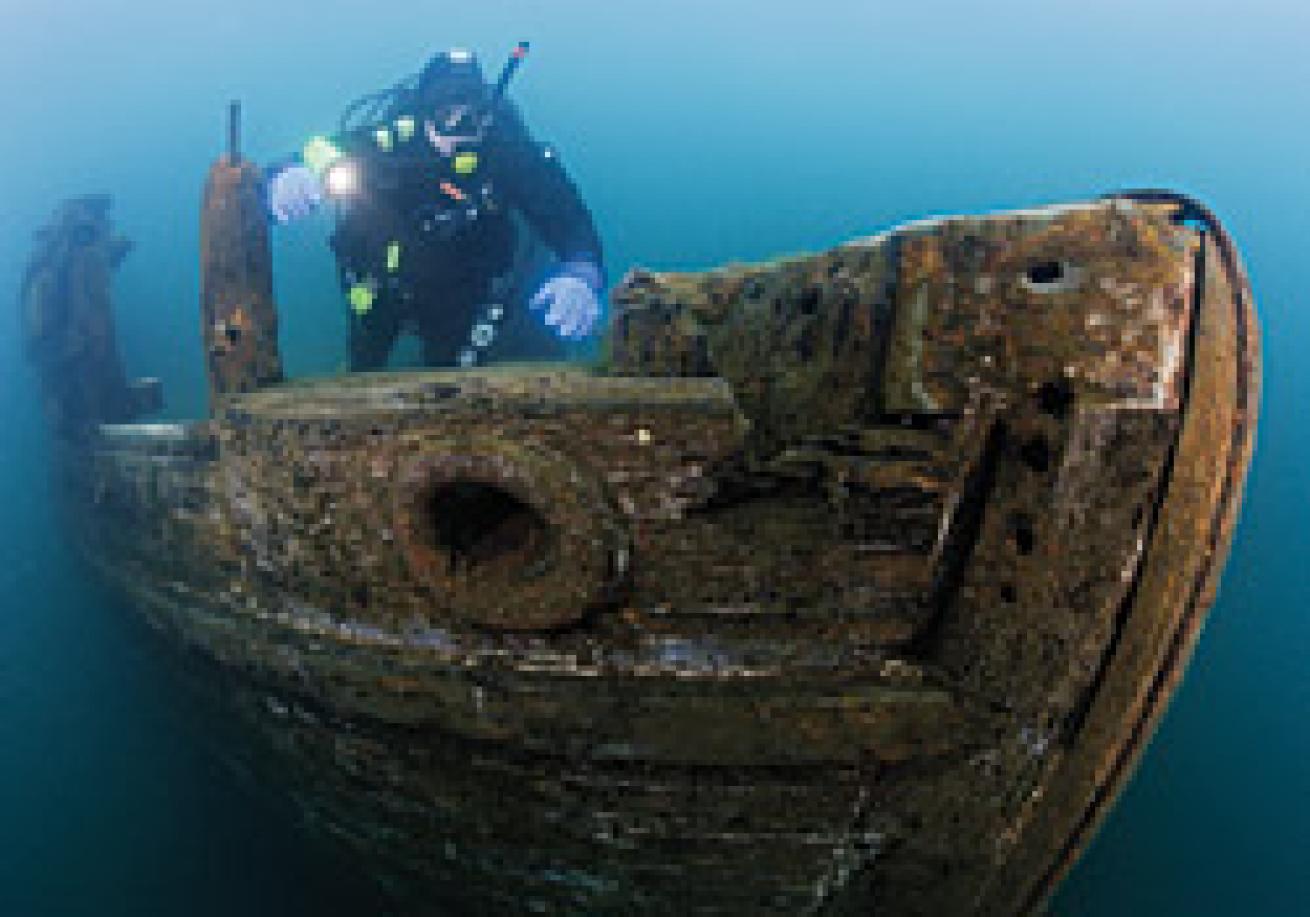
February 2007
By Jim Lima
Photography by Brandon Cole
As I descend the line from the surface buoy, the dark shape below morphs into the unmistakable form of a sailing ship. At 60 feet, I hover above the 130-foot-long Maitland, orienting myself for a stem-to-stern survey. The Maitland is one of the many exceptional shipwrecks that draw divers to Michigan's Upper Peninsula, or the "U.P."
In its decade sailing the Great Lakes, the Maitland survived many mishaps before an accident sent it to the bottom of the Straits of Mackinac, the passage at the northern tip of two Great Lakes, Lake Michigan and Lake Huron. Capt. Larry MacElroy, of the dive boat Rec Diver, calls the Maitland the "good luck/bad luck wreck." On a clear night in June 1871, "the lookout spotted an oncoming vessel," he says. "The Maitland turned hard to avoid a collision. Its bowsprit tangled and broke away with the rigging and a mast from the other boat, but both ships stayed afloat. But the Maitland's good luck had been used. Moments later, an unseen second vessel hit it square, slicing through the hull. The Maitland went down in five minutes."
We find evidence of the first collision: the bowsprit's stub pokes from the front of the wreck. On the foredeck, we inspect the massive sampson post, the windlass and other fixtures. We drop to the main deck, where a hatch opening reveals a cavernous hold, but entering the wreck is not part of our dive plan. A gap in the starboard gunwale catches my attention. The point of second impact! Kicking over, I discover staved-in timbers that breach the hull from top to bottom. I experience an unexpected twinge of sadness while probing the fatal rupture, evidence of the ship's tragic ending.
Wrecks of the Straits of Mackinac
The Straits funneled ships into a confined area, which, in conspiracy with the weather, created a wreck-rich environment. The Maitland is among 13 of the main historic wrecks in or adjacent to the Straits of Mackinac Underwater Preserve. Most of these sites are advanced dives because of depth (many are deeper than 75 feet) and variable current.
We motor east to dive the Sandusky, the preserve's oldest wreck. It foundered in a September 1856 gale with the loss of all hands. Well-preserved in Lake Michigan's cold waters, it sits upright in about 85 feet of water, with the deck at 70 feet. The photogenic bow features a prominent jib boom and bowsprit, and the site's most unique feature, a ram-shaped figurehead. We make our way around collapsed masts, anchors, the windlass and other remains strewn about the bow and bottom.
The Sandusky and the Maitland appear swathed with an uneven, rough-textured coat that turns out to be countless thumbnail-sized zebra mussels. This non-native species, most likely introduced in ballast water discharged from a transoceanic vessel in the late 1980s, has spread quickly across much of the Great Lakes.
Alger Underwater Preserve
A two-hour drive through a landscape of farmland and forests takes us from St. Ignace to Munising, on the U.P.'s north shore. We dive a cluster of wrecks, many of which are well suited for novice divers, in Lake Superior's Alger Underwater Preserve.
From our boat's deck, we can easily make out the submerged outline of the Bermuda. The Bermuda sank twice, foundering in 1870 while carrying a cargo of iron ore and again 13 years later after being raised during salvage. The top of the stern sits in about 12 feet of water with the bottom of the bow around 30 feet. "If you have any problem on the wreck," quips our captain, Peter Linquist, during the briefing, "stand on the deck, wave your hand, and you'll be OK."
Descending to the Bermuda's bow, we find its largely intact hull devoid of encrusting zebra mussels. The caulking between the planks still looks tight; the hull appears as if it could be refloated and repaired and then resume duty. We find remnants of the iron ore cargo in the hold and scattered on deck.
In contrast, our dive in 20 to 40 feet of water on the nearby Manhattan reveals a confusing pile of broken timbers inhabited by scores of crayfish. This site invites us to solve the jigsaw puzzle of how these pieces relate to one another. The wreck sits adjacent to the boulder reef that stranded the ship and broke open its hull. Charred timbers mark the fire that finished it off. We can make out depth markings, indicated by the Roman numerals XIV and XV, on the detached rudder.
The Smith Moore, a wood-hulled steamer lost in an 1889 collision, is deeper, colder and more exposed to the elements than the two nearby sites, making it an advanced dive. As suggested in our predive briefing, we descend on the buoy line and limit our exploration to the wreck's stern. Circling the deck, we come across portions of the steam engine, piping and plumbing. Pulleys and other implements hang from the railing, and a fine sand coating covers much of the deck. We descend to a maximum of 80 feet during the dive; published dive guides indicate a greater depth, but the bottom's shifting sands constantly change the conditions at this site.
Keweenaw Underwater Preserve
We load the van for the four-hour trip to Copper Harbor, our final destination. The journey takes us through the Huron Mountains before we head up the Keweenaw Peninsula, which juts into Lake Superior. We emerge at the town of Copper Harbor, which literally sits at the end of a beautiful, tree-shaded road.
Aboard the charter boat Equinox, we cruise toward the former Coast Guard buoy tender Mesquite, one of several wrecks in the Keweenaw Underwater Preserve. After running aground in 1988 and being damaged beyond repair, the Mesquite was intentionally scuttled in about 110 feet of water to create a dive site. Rounding Keweenaw Point, we feel the bump of three-foot seas driven by easterly winds. Lake diving may conjure visions of idyllically calm water, but these inland seas exhibit the same unpredictable temperament as their saltwater cousins.
We giant-stride into the water and descend to the vessel 80 feet below. The Mesquite turns out to be in excellent condition, offering a variety of deck machinery and other fittings and diver-accessible compartments.
We run back to Copper Harbor to dive the Wasaga, marked by a buoy fashioned from an aluminum beer barrel. The ship burned and sank in the harbor in 1910. Today, the site consists of a jumble of timbers, some of which still show marks of the vessel's fiery demise. Like the Manhattan, this dive is fairly easy, with widely scattered wreckage in 20 to 40 feet of water. Closer inspection reveals bricks, coal, spools of rusting barbed wire and other remnants of its cargo of farm machinery.
Freshwater diving eliminates the need for a lengthy gear rinse at the end of the dive, so we quickly pile into the van and backtrack to Marquette. While flying prevents us from diving in the Marquette Underwater Preserve, the city's maritime museum, lighthouse and ore-loading docks provide a larger context for the wrecks we did explore.
The 11 underwater preserves that ring Michigan do more than protect historically significant wrecks in historically significant areas. They allow divers of all skill levels to experience the thrill of discovery that comes with exploring a shipwreck.
InDepth
Getting Around: The Upper Peninsula has an excellent road system with access to St. Ignace via Interstate 75 and the Mackinac Bridge, from Canada through Sault Ste. Marie, and from several points in Wisconsin.
Dive Conditions: The best diving conditions in the preserves occur in July and August, but can remain good until after Labor Day. Depending on location and conditions, diving generally opens in late April or early May when the preserve associations place buoys on the wrecks and usually ends sometime between mid-September and early October when the buoys are removed. Visibility varies, but commonly exceeds 20 to 40 feet during the peak season. Water temperatures at the surface during the peak season can be in the upper 50s or warmer. Weather conditions can make the lakes "turn over," bringing colder water to the surface. Temperatures on the deeper wrecks generally hover in the upper 40s or colder. In any case, a dry suit is recommended, but some divers opt for thick wetsuits.
Dive Outfitters and Charters: For most trips, two-tank dives are the norm, with scheduled trips in the morning and afternoon. Most dive outfitters and charters operate seasonally and part-time. Dive charters accommodate three to 24 divers. Rental gear is available but limited. While same-day, walk-on diving is possible on some boats, reservations are highly recommended.
Straits of Mackinac Underwater Preserve: In St. Ignace, Straits Scuba Center, www.straitsscuba.com, and Abyss Dive Charters, www.abyssdivecharters.com.
In Mackinac City, Great Lakes Dive Charters, www.greatlakesdivecharters.com.
In Traverse City, Scuba North, www.scubanorth.com.
Alger Underwater Preserve: In Musining, Shipwreck Tours, www.shipwrecktours.com, and Northstar Charters, www.lakesuperiordiving.com.
Keweenaw Underwater Preserve: In Copper Harbor, A Superior Divers Center, www.asuperiordive.com, and Fred's Charters, www.copperharbor.org/site_files/freds.html.
Topside Activities: The Upper Peninsula is renowned for its maritime sites, including shipwrecks, underwater preserves, lighthouses and maritime museums.
Information on the UP is available from these web sites: Upper Peninsula Travel, www.uptravel.com • Marquette Convention and Visitors Bureau, www.marquettecountry.org • Straits of Mackinac Underwater Preserve, St. Ignace Visitors Bureau, www.stignace.com • Alger Underwater Preserve, Alger County Chamber of Commerce, www.algercounty.org • Keweenaw Underwater Preserve, Copper Harbor, www.copperharbor.org.
Note: While Michigan's Underwater Preserve system protects wrecks in designated areas, removing any artifact from any wreck anywhere on the state's bottom lands is illegal. Information on diving the various preserves and wrecks can be found at www.michiganpreserves.org.
